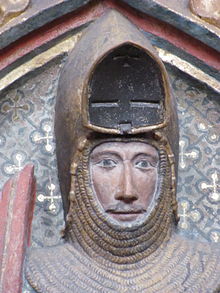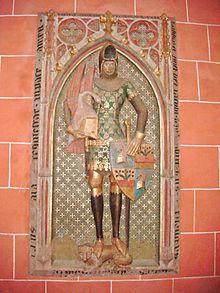Rudolf von Sachsenhausen
Rudolf II. Von Praunheim , called von Sachsenhausen , (first mentioned 1318; † July 26th of an unknown year after 1371 ) from the family of the lords of Praunheim was a knight (" miles de Prumheim "), ministerial officer , city scholar of Frankfurt am Main and Viscount of Castle County Friedberg of Friedberg in Friedberg (Hessen) .
family
The lords of Praunheim had come into possession through inheritance or dowry that came from the lords of Sachsenhausen . Some members of the “von Praunheim” family therefore also called themselves “von Sachsenhausen”. Rudolf II von Sachsenhausen's father was Heinrich IV von Praunheim (-Sachsenhausen) (* around 1260, named from 1279; † between 1303 and 1305) who was also mayor of Frankfurt. Rudolf II's mother was called "Liutgard". Rudolf II had several siblings. It is noteworthy that he and not his older brother Wolfram IV († after 1320) followed his father first in 1318 in the imperial fiefdom and later in the office of imperial school. The older brother was married, but his only known son, Johannes, died as a child.
Rudolf II was married twice and had several children from each woman:
- Clara von Hornau (mentioned 1333; † September 21 in a year between 1342 and 1344)
- Wolfram IV. (Mentioned between 1347 and 1380), unmarried, lived in the family mansion in Frankfurt-Sachsenhausen
- Gertrud (mentioned 1372, 1380; † before 1385), married to Heinrich von Kalsmunt
- Eilke (mentioned 1372, 1380), married to Philipp von Montfort
- Elsa (mentioned between 1348 and 1395), nun , most recently master in the monastery of Retters
- Jutta (mentioned between 1348 and 1361), initially a nun (Kloster Retters), later married to Friedrich, Vogt von Ursel , mentioned in 1361 as a widow
- Christine († before 1400), married before 1345
- Rudolf III. von Praunheim -Sachsenhausen (mentioned from 1374; † 1413), later followed his father as mayor of Frankfurt and was Burgmann of Friedberg Castle, married to Irmele / Ermel von Blankenheim
- Friedrich (mentioned from 1374; † before 1416), married: 1. Freya, 2. Elsa von Beldersheim
- Wolf von Praunheim-Sachsenhausen (mentioned from 1374; † before 1411), Frankfurt bailiff in Goldstein
- Gela (mentioned in 1383), married to Heinrich von Handschuhsheim
Career
The oldest surviving mention of Rudolf von Sachsenhausen comes from the year 1318 as miles de Prumheim (Knight of Praunheim), since 1321 as miles de Sassenhusen (Knight of Sachsenhausen). In 1325 he and his brothers donated two altars and two vicarages in the Imperial Cathedral of St. Bartholomew in Frankfurt am Main.
Relationship to the Empire
Politically, Rudolf von Sachsenhausen was close to the kings Ludwig the Bavarian , Günther von Schwarzburg and then his rival Karl IV , which promoted his career in their service and gave him a number of high offices and numerous fiefdoms in the Rhine-Main area (then: Wetterau ) brought in. He accompanied King Ludwig in 1327 to his Rome procession and his coronation as emperor . Rudolf II also belonged to the circle of Ulrich II. , Who appointed him executor and Ulrich III. von Hanau (approx. 1310–1369 / 70), governor in the Wetterau.
In 1333 he was - a reward for his participation in the Rome procession of the now emperor Ludwig IV - burgrave of the Reichsburg Friedberg .
Reichsschultheissenamt
Rudolf became mayor of Frankfurt am Main in 1338 and held this office until 1340 or 1341. The office was still very prestigious at the beginning of the 14th century, but had lost power. The bourgeoisie was economically strengthened and used its financial strength to buy royal powers such as the maintenance of public order, tax and customs duties from the hands of the kings. In addition, in contrast to other areas of public administration, the office of Reichsschultheissen was carried out without written procedures, archives and administration. The owners of the Reichsschultheißenamt failed to modernize it in keeping with the times. The consequence was that the income from the office fell and it lost political importance. The Reichsschultheissen retained his function as the supreme court lord, but he had lost all influence on the composition of municipal bodies.
For Rudolf II von Sachsenhausen, this office was only one of several on which he relied. His attempts to strengthen it against the progressive loss of meaning were permanently unsuccessful. With his "career kink" in 1342, his efforts are considered to have failed.
Manorial rule
The village of Niederrad belonged to him and until 1356 he owned the village of Schwanheim from Gottfried von Eppstein as a pledge . He was also fortunate with income from the Rhine toll of Ehrenfels Castle , which he received from King Günther for his help in reaching for the royal crown, a residence tax for Jews in the city of Frankfurt, with other taxes and with property and rights of use and in the Locations: Bürgel , Frankfurt am Main, Harheim , Heldenbergen , Karben , Kriftel , Messenhausen , Offenbach am Main , Praunheim , Preungesheim , Roßdorf , Sachsenhausen , Sossenheim , Sulzbach , Wachenbuchen and Wenig .
This extensive possession also gave Rudolf II economic power. For example, Gottfried VIII von Eppstein was one of his debtors with considerable amounts. In contrast to the unsuccessful modernization of the administration at the Reichsschultheißenamt, he introduced advanced methods such as written procedures in the administration of his own property. For example, inventories of the property of the von Praunheim family were created.
After 1342
In 1342 the sources on Rudolf II fell silent for the time being. He can no longer be proven in any of his imperial offices and his first wife must have died during this time. He married a second time. It did not regain its former importance. Occasionally he is mentioned as serving in diplomatic missions. So he tried about in the 1360s in the conflict between Ulrich III. by Hanau and Philipp VI. von Falkenstein ( Falkensteiner Feud ) to convey.
In 1349 Rudolf II became active again in imperial affairs as a supporter of Günther von Schwarzburg. When he turned to Charles IV, he got away without damage and now acted as a supporter of the new king. After King Günther's death, which followed shortly afterwards, he continued to work as an advisor to his family and organized a burial site (1352) and an annual memorial for the deceased in the Imperial Cathedral of St. Bartholomew. The tomb therefore bears the coat of arms of Rudolf II von Sachsenhausen. At the same time he often stayed at the court of Charles IV and worked in his service, which is evidenced by a series of royal favors to him.
death
Rudolf was buried in the Imperial Cathedral of St. Bartholomew. His tomb is preserved on the west wall of the north transept of the church.
inscription
| Its Latin transcription reads: | In translation: |
|---|---|
| " Anno dni MCCCLXX prima sabbato post beati Jacobi apostoli obiit dominus miles des Sachsenhusen, cuius anima requiescat in pace, Amen ". | “ In the year 1370 [and] one, on the Saturday after the [day of] Saint Jacob , Mr. Rudolf, Knight of Sachsenh [a] usen, died, whose soul may rest in peace. Amen ”. |
Descendants
After his death, his numerous children became embroiled in extensive inheritance disputes resulting from the unequal distribution of inheritance between the children of his two marriages. The parties initially argued before the municipal aldermen's court in Frankfurt, whereby, according to the court's records, there was mutual abuse, in the second instance before the royal court in Prague . The children from their first marriage succeeded in first having their siblings from their second marriage imposed under the imperial ban. When they presented themselves to the court, the process was referred to the courts of the archbishops of Trier and Mainz . The exact outcome of the dispute is not known; The majority of the property remained with the children from the second marriage.
The eldest son of Rudolf II from his second marriage, Rudolf III. von Praunheim- Sachsenhausen was the last of the family to exercise the mayor's office again in 1376.
Varia
Worms Bishop Johann Karl von und zu Franckenstein , who was also buried in Frankfurt Cathedral, was a direct descendant of Rudolf von Sachsenhausen and, according to his own (now destroyed) epitaph, renewed the inscription on St. Bartholomew's altar and the foundations of Rudolf II.
literature
- Euler: The Lords of Sachsenhausen and Praunheim. A genealogical attempt . In: Archive for Frankfurt History and Art . 1854, pp. 38-113. here as an electronic resource.
- Alfred Friese: The Lords of Praunheim-Sachsenhausen, inheritance of the Reich in Frankfurt am Main. Property, social and cultural history of an imperial ministerial family from the high and late Middle Ages . Bonn 1952 (Masch. Diss. 1952), pp. 71-80.
- Sabine Hock : Sachsenhausen, Rudolf . In: Wolfgang Klötzer (Ed.): Frankfurter Biographie . Personal history lexicon . Second volume. M – Z (= publications of the Frankfurt Historical Commission . Volume XIX , no. 2 ). Waldemar Kramer, Frankfurt am Main 1996, ISBN 3-7829-0459-1 . Pp. 231-232
- Johann Mader: Imperial Knighthood Magazine 1780–1790, Vol. 2, P. 120. here as an electronic resource.
Web links
- "Sachsenhausen, Rudolf Ritter von". Hessian biography. In: Landesgeschichtliches Informationssystem Hessen (LAGIS).
Individual evidence
- ↑ Friese, p. 74, concludes that from notarizations of her son.
- ↑ Friese, p. 72a.
- ^ So: Thomas Schilp: The Reichsburg Friedberg in the Middle Ages. Studies of their constitution, administration and politics . Friedberg 1982, pp. 87-90; Klaus-Dieter Rack: Friedberg Castle in the Old Kingdom: Studies on its constitutional and social history between the 15th and 19th centuries . Darmstadt 1988, p. 401, Table 16, Friese, p. 74; not applicable: 1342, see above: Hock, Euler, p. 78, and LAGIS.
- ↑ Friese, p. 72.
- ↑ PDF document on the grave of Bishop Franckenstein and his relatives with Rudolf von Sachsenhausen ( Memento of the original from May 12, 2013 in the Internet Archive ) Info: The archive link has been inserted automatically and has not yet been checked. Please check the original and archive link according to the instructions and then remove this notice.
| personal data | |
|---|---|
| SURNAME | Rudolf von Sachsenhausen |
| BRIEF DESCRIPTION | Burgrave of Friedberg, mayor of Frankfurt am Main |
| DATE OF BIRTH | 13th century or 14th century |
| DATE OF DEATH | July 26, 1371 |


